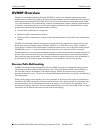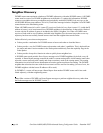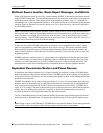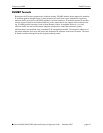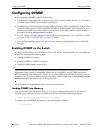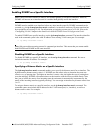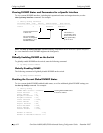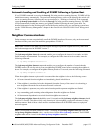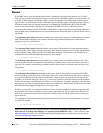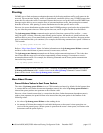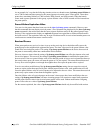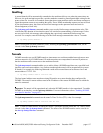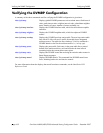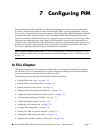
Configuring DVMRP Configuring DVMRP
OmniSwitch 6800/6850/9000 Advanced Routing Configuration Guide December 2007 page 6-13
Automatic Loading and Enabling of DVMRP Following a System Boot
If any DVMRP command is saved to the boot.cfg file in the post-boot running directory, DVMRP will be
loaded into memory automatically. The post-boot running directory refers to the directory the switch will
use as its running directory following the next system boot (i.e., Working or Certified). If the command
syntax ip dvmrp status enable is saved to the boot.cfg file in the post-boot running directory, DVMRP
will be automatically loaded into memory and globally enabled following the next system boot. For
detailed information on the Working and Certified directories and how they are used during system boot,
see the “CMM Directory Management” chapter in the OmniSwitch 6800/6850/9000 Switch Management
Guide.
Neighbor Communications
Probe messages are sent out periodically on all the DVMRP interfaces. However, only on the non-tunnel
interfaces are they sent out to the multicast group address 224.0.0.4.
Note. Older versions of DVMRP use Route Report messages to perform neighbor discovery rather than
the Probe messages used in DVMRP Version 3.
The ip dvmrp neighbor-interval command enables you to configure the interval, in seconds, at which
Probe messages are transmitted. For example, to configure the Probe interval to ten seconds, enter the
following command:
-> ip dvmrp neighbor-interval 10
The ip dvmrp neighbor-timeout command enables you to configure the number of seconds that the
DVMRP router will wait for activity from a neighboring DVMRP router before assuming the neighbor is
down. For example, to configure the neighbor timeout period to 35 seconds, enter the following command:
-> ip dvmrp neighbor-timeout 35
When the neighbor timeout expires and it is assumed that the neighbor is down, the following occurs:
• All routes learned from the neighbor are immediately placed in hold down.
• If the neighbor is considered to be the designated forwarder for any of the routes it is advertising, a
new designated forwarder for each source network is selected.
• If the neighbor is upstream, any cache entries based upon this upstream neighbor are flushed.
• Any outstanding grafts awaiting acknowledgments from this neighbor are flushed.
• All downstream dependencies received from this neighbor are removed.
The ip dvmrp neighbor-interval should be set to 10 seconds and the ip dvmrp neighbor-timeout should
be set to 35 seconds. This allows fairly early detection of a lost neighbor yet provides tolerance for busy
multicast routers. Both of these values must be coordinated between all DVMRP routers on a physical
network segment.
Note. Current global DVMRP parameter values—including the ip dvmrp neighbor-interval value and
the ip dvmrp neighbor-timeout value—can be viewed via the show ip dvmrp command. The DVMRP
neighbor table can be viewed via the show ip dvmrp neighbor command.



